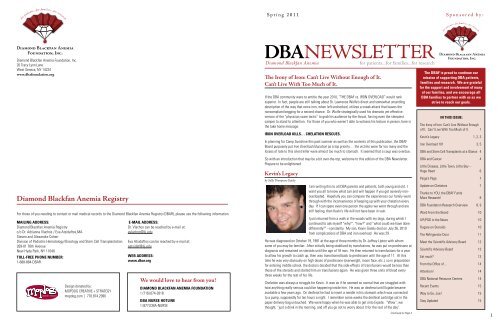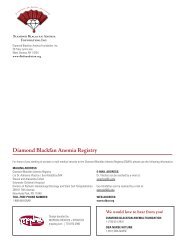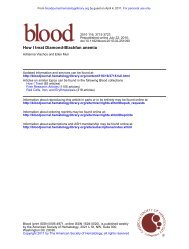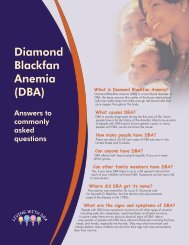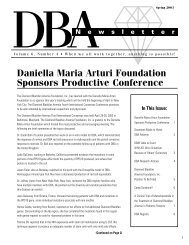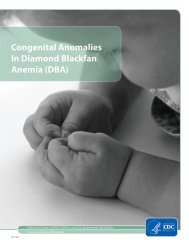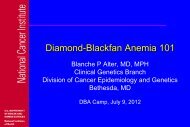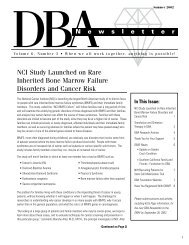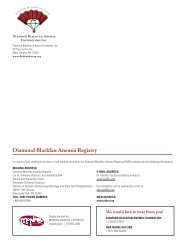Spring 2011 - Diamond Blackfan Anemia Foundation, Inc.
Spring 2011 - Diamond Blackfan Anemia Foundation, Inc.
Spring 2011 - Diamond Blackfan Anemia Foundation, Inc.
- No tags were found...
You also want an ePaper? Increase the reach of your titles
YUMPU automatically turns print PDFs into web optimized ePapers that Google loves.
Thanks to YOU, the DBAF Funds More Research!Paul de Figuieredo, Ph.D., Assistant Professor, Texas A&M University,was awarded a $43,256 grant from the DBAF for the project“Discovering therapeutics for DBA .” The long-term goal of this studyis to develop small molecule therapeutics for <strong>Diamond</strong> <strong>Blackfan</strong> <strong>Anemia</strong>(DBA), by screening for molecules that overcome growth defectsassociated with decreased expression of ribosomal protein S19 in ayeast model of DBA. Yeast are remarkably versatile microorganismsthat share many aspects of ribosome biology with humans. Due totheir small size and ease of growth, they are readily amenable tohigh throughput drug screens where thousands of compounds can beassessed for their effects on cell growth. The Figuieredo lab will screen25,000 chemical compounds for their ability to reverse the effects ofreduced expression of Rps19 on cell growth. Any compounds identifiedin the yeast screen will be examined for their ability to compensate forreduced expression of Rps19 in human cell lines. Dr. Figuieredo has hadsubstantial success using a similar approach to identify lead compoundsfor therapeutic development in another ribosome-related bone marrowfailure syndrome, Shwachman <strong>Diamond</strong> syndrome (SDS).Hanna T. Gazda, M.D., Instructor in Pediatrics Harvard MedicalSchool, was awarded $51,512 from the DBAF to continue her efforts inidentifying genes mutated in patients with DBA. Dr. Gazda has playeda major role in the identification of most of the 11 known DBA genes.Her discoveries have clearly established DBA as a ribosomopathy whichhas helped direct research efforts on many aspects of this disease.Approximately 50% of DBA patients have mutations in one of the 11known genes. In the remaining patients, the defective genes haveevaded detection by conventional DNA sequencing. Dr. Gazda nowplans to use sophisticated whole genome approaches to identify theseremaining genes. The aim of this study is (1) to perform comparativegenomic hybridization to search for deletions and duplications inribosomal protein genes that could not have been picked up by DNADBA <strong>Foundation</strong> Research OverviewBy Steve Ellis, DBAF Research DirectorI have been asked to provide an overview of research supported by the<strong>Diamond</strong> <strong>Blackfan</strong> <strong>Anemia</strong> <strong>Foundation</strong> for this edition of the newsletter.To coin a term used in business, I would say that the DBAF has a diverseresearch portfolio. As I see it, this portfolio has two major subdivisions:grant support and dissemination. The diverse nature of the portfolio isevident in both of these major subdivisions. I will focus initially on grantsupport and then tackle dissemination.Grant supportThe DBAF provides grant support for investigator-initiated researchultimately aimed at understanding the pathophysiology of DBA with aneye toward improving the lives of individuals and families living withDBA. Here, I use the term pathophysiology as a catch all to describe themolecular basis for the disease and how these changes at the molecularlevel give rise to the clinical features of the DBA, including responseto therapy. Some of the grants funded over the years could fall underthe heading of applied research or research directed toward a highlyspecialized goal. These could include grants to Drs. Lipton and Vlachosto help set up the North American DBA Registry, or grants to Dr. HannaGazda, to identify genes responsible for DBA. Other grants tend tobe more broadly based and tend to be directed toward understandingmolecular mechanisms underlying DBA. These mechanisms can, in turn,sequencing; (2) to perform whole exome sequencing (“next generation”sequencing) to potentially identify non-ribosomal protein genes thatmay be mutated in DBA. This latter approach is daunting in that tensof thousands of genes will need to be sequenced and analyzed forsequence changes that may be linked to patients with DBA. This projectwill result in a more complete picture of the genetic causes of DBA andthe pathogenic mechanisms that result.Emanuela Tolosano, Ph.D., Professor at the University of Torino Schoolof Medicine, was awarded $25,000 from the DBAF to fund a projectaimed at defining the role of the Feline Leukemia Virus, subgroup C,Receptor (FLVCR) in the pathogenesis of <strong>Diamond</strong>-<strong>Blackfan</strong> anemia(DBA). FLVCR encodes a protein that exports excess heme from cells.It has been suggested that defects in globin synthesis, perhaps as aresult of ribosomal protein mutations, could result in excess hemein erythroid progenitors that would need to be exported from cells toreduce heme toxicity. Thus, FLVCR could play an important role in DBApathogenesis. Recently, it has been reported that mice lacking FLVCRshow a phenotype very close to that of DBA patients, including erythroidfailure and malformations. However, no mutations in FLVCR have beenfound in a small subset of DBA patients. One of the goals of this studyis to test additional DBA patients for mutations in FLVCR. It is possiblehowever, that FLVCR could have a role in DBA pathogenesis withoutbeing mutated in DBA patients. Studies have shown that FLVCR isa complex gene giving rise to a number of related proteins that havedifferent functions. Moreover, different tissues may express differentforms of FLVCR protein. Given the complexity of the FLVCR gene it ispossible that mutations in ribosomal protein genes could alter FLVCRexpression. Therefore, this study will also focus on possible changesin FLVCR expression in cells with mutant forms of RPS19. Finally, theTolosano laboratory will continue to study the role of different forms ofthe FLVCR protein in erythropoiesis.give rise to new and unanticipated therapies. I used the term “broadlybased”as an approach to research funding, because time and timeagain major scientific discoveries have come from unexpected quarters.An example from the DBAF files would be Dr. Kathleen Sakamoto’s grantto study a zebrafish model of DBA. One might reasonably ask whatzebrafish could tell us about this human disorder, but Dr. Sakamoto’smodel system provided a vital link between the loss of Rps19 and p53activation, ultimately signaling to cell death pathways. This findinghas guided the field for the past few years and dissecting componentsof this pathway could lead to new therapeutic targets. More recently,DBAF support has gone to drug discovery efforts and the improvementsof animal models for DBA where the drugs could be tested.A list of investigators and grants supported over the years is givenbelow. Space limitations prevent me from discussing each name andproposal separately, but consider this list a veritable “Who’s Who” ofDBA research!Dr. Jeffrey Lipton – 1995, 1996, 2000 – DBA Registry, Molecular basisof DBADr. Niklas Dahl – 1998, 1999, 2000, 2001 – Gene Discovery, Rps19functionDr. Douglas Templeton – 1998 – Iron overloadDr. Colin Sieff – 1998, 2007, 2008 – Molecular basis of DBADr. Monhandas Narla – 1999 – Red cells/DBADr. Stefan Karlsson – 2000, 2001, 2004, 2006 – Mouse and Cellular DBAmodels, Gene therapyDr. Gil Tchernia – 2001, 2003, 2004 – DBA pathophysiology,Metoclopramide efficacy and toxicityDr. Adrianna Vlachos – 2002, 2004 – DBA Registry, Molecular basisof DBADr. Kathleen Sakamoto – 2002, 2005 – AML in DBA, Zebrafish modelsof DBADr. Sarah Ball – 2004, 2005 – Understanding and enhancing the steroidresponse in DBADr. Hanna Gazda – 2004, 2005, 2007, 2010 – Gene DiscoveryDr. Steven Ellis – 2004-present – Research director, Ribosomes and DBADr. Irma Dianzani – 2006 – The Rps19 interactomeDr. Fabrizio Loreni – 2007 – Rps19 functionDr. Johan Flygare – 2007, 2009 – Mechanism of steroid action,drug discoveryDr. Lydie DeCosta – 2009 – Cellular models of DBADr. Shuo Lin – 2009 – Zebrafish DBA modelDr. David Bodine – 2009 – Mouse DBA modelDr. Paul de Figueiredo – 2010 – Drug discoveryDr. Emanuela Tolosano – 2010 – Pathogenesis of DBAResearch Grants, review and funding decisionsProposal reviewProposals received by the DBAF are sent out for review by <strong>Foundation</strong>’sResearch Director (currently me). In general, three reviewers aresolicited for each grant. The reviewers are typically in the DBA field withexpertise in the basic science or clinical arenas. Frequently reviewersare members of the DBAF Scientific Advisory Board but other reviewersare also used. It should be pointed out that reviewers give of their timeand expertise without financial compensation. Once the reviews havebeen received I write up a summary of the reviews, and the reviews plusmy summary are forwarded to members of the DBAF Board.Funding decisionThe Board of Directors of the DBAF ultimately makes funding decisions.A number of criteria are employed in making these funding decisions.These criteria include:• Relevance to DBA, either from a clinical or basic science perspective• Scientific rigor, are the experiments or clinical trials well planned andbased on sound principles?• Productivity of investigator, does the investigator have a solid recordof scientific accomplishments?• Does the investigator has a strong commitment to the DBA field?• Does this proposal represent an opportunity to bring a newinvestigator into the DBA field?Your Help is Needed• Is this a young investigator (with fewer accomplishments to date) buthas the long term potential to contribute to the DBA field?The Board’s discussion may not only include whether or not to fund theproposal but also whether the proposal should be funded in full or if cutsin the budget should be considered.Scope of funding – from pilot projects to NIH supportIn general support from the DBAF is for pilot projects to test new ideasand obtain preliminary data for much larger proposals to governmentagencies like the NIH. Many of the researchers funded above havemaintained their research programs through support from other sourcesafter having received support from the DBAF. Of particular note in thisregard, is that several investigators listed above received grant fundingthrough an NIH program on “Molecular Mechanisms of <strong>Diamond</strong><strong>Blackfan</strong> <strong>Anemia</strong> and Other Bone Marrow Failure Syndrome” stimulatedby lobbying efforts of the Daniella Maria Arturi <strong>Foundation</strong>.DisseminationAn important part of the research enterprise is dissemination ofinformation. Communication between interested parties whetherthey be physicians, scientists, politicians, or patients and familiesis integral. The DBAF supports a number of venues that support thedissemination of information relevant to DBA. The DBAF is a regularsponsor of scientific meetings in specialized areas relevant to DBA.These meetings include the biannual meeting of the BioIron Societyand the triennial Ribosome Synthesis meeting. Clearly complicationsof iron overload are a major factor in DBA patients being treatedby transfusions. While the discovery of a number of ribosomalprotein genes as the cause of DBA has clearly established DBA as aribosomopathy affecting ribosome synthesis. Sponsorship of thesemeetings heightens awareness of DBA among these investigators andhelps recruit new investigators into the field.The DBAF has also been a long time supporter of the premier showcaseof DBA research, the DBA International Consensus Conference hostedby the Daniella Maria Arturi <strong>Foundation</strong>. This meeting brings togetherleading investigators in DBA and related fields for the free exchange ofinformation and ideas and has fostered many collaborations that havecontributed substantially to our understanding of DBA pathophysiology.Finally, the DBAF organizes and sponsors the scientific sessions at CampSunshine where attending families regularly hear the latest in DBAresearch from both basic scientists and clinicians.I hope you will find this brief overview of research sponsored by the<strong>Diamond</strong> <strong>Blackfan</strong> <strong>Anemia</strong> <strong>Foundation</strong> informative. I hope that I haveconveyed to you the excitement that has been building in this researcharea for the past few years and how we now stand poised to translatesome of these basic science discoveries to clinical application. It hasbeen an honor to serve as the Research Director for the DBA <strong>Foundation</strong>these past 7 years.The DBA <strong>Foundation</strong> is proud of the accomplishments that our families and friends have made possible through their fundraisers, personal contributions,and monthly donations. Currently, we have an unprecedented number of research proposals awaiting review. Our hope is to be able to fund all of theapproved projects. We cannot do this without your help!We appreciate everyone’s involvement and hope that you will join us in our efforts to understand DBA and find better treatment options for our patients.We recognize that while there are many worthy causes, the rarity of DBA places an extra burden on our families. We rely on your commitment to DBApatients to further our mission of providing support for DBA patients… families… research.To get involved, please contact Dawn Baumgardner at 716.674.2818. THANK YOU!8 9
Word From the BoardBy Anita Shier BrutonHappy <strong>Spring</strong>! My name is Anita Shier Bruton. I am a DBAF BoardMember and the DBAF Webmaster. My son, Gabriel, who turned six theday before Halloween, has DBA. He is transfusion dependent, steroidnon-responsive, and takes Exjade. My daughter Grace is four anddoesn’t have DBA- as far as we know. Like 50% of DBA patients, wedon’t know what mutation my son Gabriel has but are eager to find out.Fortunately, we are at an exciting time in scientific research. Since ourlast newsletter, we had our priceless DBA week at Camp Sunshine andhave funded more research. At camp, the DBAF presented Dr. Gazdawith a check for $51,512 to further her studies in finding the unknowngenes. Dr. Gazda’s research was paramount in finding most of the11 mutations in ribosomal protein genes, accounting for 50% of DBApatients. The focus of her research, at this point, is expanding out fromthose 80 ribosomal protein genes to other areas of the human genome.For a more detailed description of her work and other projects recentlyfunded, please go to www.dbafoundation.org and click on DBA News.Some of the research that the DBAF is able to fund is looking for theseunknown genes, while some is approaching it from other angles such asdiscovering therapeutics for the DBA.Being a biology teacher living in the realm of DBA really has itsperks. Not only do I get to immerse myself in the new research anddiscoveries, but I also get to educate my students about DBA and theamazing progress that has taken place in just the last ten years. Therehave been ground-breaking studies in developmental evolution (evodevo), the human genome project, RNA, ribosomes, and the list goeson. The fields of science that have been studying DBA come from manydifferent angles and, although they seem to be quite different, it isbecause of those different approaches that important connections arebeing made. Discovering that DBA is a ribosome-based disorder is justone example. One of the newest avenues is looking at what scientistshave been calling junk DNA which makes up about 98% of our genome.Some is viral, some areas are called pseudogenes (sections of our DNAthat originate from our ancestors but no longer code for proteins), someare switches, and some are still unknown as to their function. Theintricate design of who we are is slowly getting clearer and, as it does,by continuing to fund research through your contributions to the DBAF,DBA is right there to reap the rewards.As a DBA mom and a scientist, I am really excited about what may befound in those unknown areas. As I watch my son play and wonder whathis future may hold, all I can feel is hope. I am constantly inspired andgrateful by the science that is happening around the world to actively beworking toward unraveling this mystery. Fundraising is so very vital toour common search for a cure. It doesn’t matter if it is a small event oreffort; every little bit counts. If you are newly interested in fundraising,here are some ideas in which you could start small: bake sale, garagesale, car wash, GoodSearch/GoodShop, DBAF bracelets, letter writingto friends and family, birthday wish, or holiday wish. I am also able toupload your loved one’s picture on the DBAF brochure so you can print amore personal brochure to have available at your event.If you would like to have your DBA patient’s picture, CaringBridge/CarePage link, fundraiser, or have a family DBA article or news link onthe website, you can email them to me at asbruton@dbafoundation.org.If you haven’t already registered or if you’ve moved, please sign up onthe website under “For Families” on the navigation bar so we can sendyou the DBAF newsletter and other educational materials.Sometimes the journey we are traveling isn’t easy, but I am so gratefulfor our DBA community. Armed with your support, I can honestly saythat I am incredibly hopeful about the future of DBA. Together we cando this, and we will continue to fight for the cause and a cure for DBA.In closing, the DBAF looks forward to being a resource and support toyou and your family on this DBA journey.Many blessings,Anita Shier Brutonasbruton@dbafoundation.orgDBA <strong>Foundation</strong> Board Member and Webmasterwww.dbafoundation.orgIVF/PGD in the NewsMany of us are familiar with this technology thanks to the TrebingFamily who made pre-implantation genetic diagnosis (PGD) ahousehold name within the DBA community when a book abouttheir journey, The Match by Beth Whitehouse, was publishedabout a year ago. Dr. James Stelling is the reproductive specialistresponsible for orchestrating the miracle on miracle that alloweda baby boy, free of DBA and a perfect sibling match, to provide thelife-saving marrow that gave little Katie Trebing a chance to be thebig sister that Christopher needed.Dr. Stelling visited Camp Sunshine to share information on theadvances in science and medicine that enable dreams to come truefor families stricken with genetic disorders like DBA. AlthoughPGD/IVF is not an option for everyone, many families foundthemselves inspired by his detailed description of “how babies aremade” in his laboratory. For more information on pre-implantationdiagnosis with in vitro fertilization, please visit rsofny.comor genesisgenetics .org. Dr. Stelling can also be reached at(516) 739-2100.Flygare on SteroidsIt has been maintained by physicians and researchers that althoughwe realize that Prednisone works to eliminate the need for bloodtransfusions in many diagnosed with DBA, we still do not fullyunderstand why this drug works to stimulate red cell production. AtCamp Sunshine this past July, Johan Flygare, MD PhD took some time tospeak about what he is doing on this front to improve the lives of thosewith DBA who struggle with the side-effects of chronic steroid use.We know that Prednisone activates the glucocorticoid receptor whichthen goes into the cell nucleus. In the nucleus the glucocorticoidreceptor will turn some genes on and others off, but we have no idea ofwhich genes it turns on or off in order to improve red cell production inDBA. Work is being done to understand this process in hopes of findingother drugs that activate the glucocorticoid receptor as Prednisone doesbut have a more specific effect on the genes important for DBA andless effect on genes that cause side effects. It may also be possibleto identify other drugs that regulate the Prednisone-regulated genesthat improve red cell production in DBA but do so independently of theglucocorticoid receptor. Such compounds could boost the effect of oreven replace Prednisone.The Refrigerator DoorDo you have a beautiful picture hanging in your home that you would like to share? The DBANewsletter is requesting submissions of your or your children’s artwork, photography, poems,short stories, etc. to include in this publication. Please send a copy of your work to JacyDowney at 1200 W. Euclid Indianola, IA 50125 or electronically to jdowney@dbafoundation.org.Peyton Green shares her interpretation of a red blood cell.Finn Gunderson’s rendition of ladybugs and jellyfish.10 11
Meet the Scientific Advisory BoardScientific Advisory BoardIn each issue of the DBA Newsletter we will spotlight a member of theDBAF Scientific Advisory Board. The <strong>Foundation</strong> is very lucky to have anesteemed group of medical professionals who are dedicated to workingwith the Board to achieve our mission. Dr. Johnson M. Liu, M.D. is anAdult Hematologist at Cohen Children’s Medical Center of New York(formerly Schneider’s) and has taken a special interest in transitioningDBA patients from pediatric to adult care. Dr. Liu has offered his advicein the form of a Q & A session.Taking Charge of Your DBA: A Message for the Young AdultQ: What is the most important thing you can do as a young adultDBA patient?A: From my perspective as an Adult Hematologist, my most importantmessage is to take charge of your DBA. Try to learn as much as you canabout what you need to do to care for yourself and be aware of some ofthe complications of DBA. Start looking for an Adult Hematologist whois interested in blood diseases like DBA as a teenager so to ease thetransition from your Pediatrician to that Adult Specialist.Q: What do we know about adult DBA patients? Are there anyconcerns that are specific to adults?A: With advances in supportive care, transfusion and steroid therapy,and stem cell transplantation, DBA is evolving from an exclusivelychildhood disorder to a disorder also affecting adults. There are knownDBA patients who survive late into adulthood, as well as patients newlydiagnosed as adults. Due to a lack of information, however, there aremany unanswered questions about how the disease progresses andwhat factors lead to long-term survival. It is also unclear whether DBAworsens over time. Cancer is also part of the natural history, but thetrue risk of cancer is not known at the present time.There are some concerns that may be specific to adult patients, namelypost-adolescence and hormonal changes; aging; concomitant chronicdiseases (heart disease); sexually transmitted diseases; lifestylediseases (alcohol abuse, smoking, illicit drugs); fertility and pregnancy;psychosocial and financial concerns. Thus, the lifetime management ofDBA patients by a multidisciplinary team may include pediatric and adulthematologists, internists and subspecialists. The challenge is to find agroup of physicians that is committed to this approach.Q: Can you give a few pointers about iron overload management?A: First, we need to be aware that iron overload from blood transfusionsis an extremely important cause of problems and death in DBApatients. Specifically, patients can suffer from dilated cardiomyopathy(heart failure), liver fibrosis and cirrhosis, and numerous endocrinecomplications such as growth retardation, failure of sexual maturation,diabetes mellitus, and insufficiency of parathyroid, thyroid, pituitary, andadrenal glands.One unit of blood contains about 200-250 mg of iron. Therefore, apatient receiving 15-30 units of blood/year receives between 3-6 gm ofiron (which is 3-6 times the annual requirement). There is a wide rangeof variability in the degree of organ toxicity among persons with thesame amount of tissue iron. Consequently, both organ function (heart,endocrine system) and tissue iron concentration must be monitored.Heart involvement is the most life-threatening iron-related complication.MRI (magnetic resonance imaging) is an accurate and noninvasivemeans of measuring the amount of iron in the heart and liver.In the USA, both Desferal (DEFEROXAMINE) and Exjade (DEFERASIROX)are approved for chelating iron. They each can cause side effects andneed to be monitored carefully. Another drug that can be effective but isavailable in the USA only on research studies is L1 / DEFERIPRONE.Q: How about steroid therapy complications and osteoporosis?A: Steroids are associated with weight gain, diabetes mellitus,adrenal suppression, hypertension, psychiatric and cognitive changes,osteoporosis, and avascular necrosis (usually of the femoral head).I particularly want to talk about steroid-induced osteoporosis, whichis under-recognized and under-treated. Steroids can cause rapid boneloss and increased fracture risk early in the course of therapy. At thistime, drugs called biphosphonates are the main treatment option forpreventing broken bones due to steroid-induced osteoporosis.Q: Can you talk about the management of pregnancy in womenwith DBA?A: First off, I should say that improvements in the management ofpregnant women with DBA have resulted in an increase in survival,quality of life and reproductive potential. Consequently, DBA womenwho have reached childbearing age in good condition are now willingand able to experience pregnancy. Of course, since DBA is a geneticdisorder, there is a 50% recurrence risk in offspring from a DBA parent.No prospective study on pregnancy in women with DBA is available.However, there have been many case reports in the medical literature.Complications of pregnancy can occur in the mother, the child, or both.Some of these potential hazards include fetal loss, pre-eclampsia,preterm delivery, intra-uterine death, infants with intra-uterine growthretardation and children with birth defects.One important thing to keep in mind is that iron chelation therapycannot be continued during pregnancy as deferoxamine may cause birthdefects. Therefore, chelation should stop when the patient is planningto become pregnant, or as soon as a pregnancy is recognized. To theextent possible pregnancy should be planned, and when necessary,an intensification of iron chelation should be performed beforecontraception. Any woman with DBA contemplating pregnancy shouldundergo a thorough evaluation of any feature that may interfere withpregnancy outcome, including the presence of blood-borne infections,iron overload and related diabetes mellitus, hypothyroidism orcardiomyopathy. Care should be administered in a high-risk obstetricalpractice in collaboration with hematologists and other specialists. <strong>Inc</strong>ases where the father of the child is the DBA-affected individual, thepregnancy should also be considered high risk and be closely monitoredfor signs of fetal distress, hydrops fetalis and other complications of thefetus.Steroid responsive women often experience an increased steroidrequirement or become transfusion-dependent during pregnancy. Inmost cases, increasing the pre-pregnancy steroid dose fails to maintaina satisfactory hemoglobin level. Steroid toxicity must be consideredin both the mother and the fetus. Many times, transfusion therapybecomes necessary during pregnancy.Steve Ellis, Ph.D.DBAF Research DirectorProfessorDepartment of Biochemistry and MolecularBiologyUniversity of LouisvilleLouisville, KYGeorge R. Buchanan, M.D.Professor of Pediatrics and Division DirectorPediatric Hematology-OncologyUniversity of Texas Southwestern MedicalCenter at DallasDallas, TexasBertil Glader, M.D., Ph.D.Professor of Pediatrics and PathologyStanford University Medical CenterPediatric Hematology/OncologyPalo Alto, CAMedical Director, Red Blood Cell SpecialStudies LaboratoryStanford Clinical Laboratories at HillviewStanford, CAJeffrey M. Lipton, M.D., Ph.D.Director, Pediatric Hematology/Oncology andStem Cell TransplantationSteven and Alexandra Cohen Children’sHospitalNew Hyde Park, NYProfessor of Pediatrics, Albert Einstein Collegeof MedicineBronx, NYJohnson M. Liu, M.D.Director, Les Nelkin Memorial PediatricOncology LaboratorySection Head, Experimental Hematology-OncologySteven and Alexandra Cohen Children’sHospitalNew Hyde Park, NYAssociate Professor of Pediatrics, AlbertEinstein College of MedicineBronx, NYHua Lu, Ph.D.Daniel and Lori Afroymson, Professor ofOncologyProfessor of Biochemistry and MolecularBiologyDepartment of Biochemistry and MolecularBiologyIndiana University School of MedicineIndianapolis, INKathleen Sakamoto, M.D., Ph.D.Professor and Chief, Division of Hematology-OncologyVice-Chair of ResearchDepartment of PediatricsDepartment of Pathology & LaboratoryMedicine11-234 FactorMolecular Biology InstituteCalifornia NanosystemsDavid Geffen School of Medicine, UCLAVisiting Associate, Division of BiologyCalifornia Institute of TechnologyLos Angeles, CaliforniaAkiko Shimamura, M.D., Ph.D.Associate Member, Fred Hutchinson CancerResearch CenterAssociate Professor of Pediatrics, Universityof WashingtonDirector, Bone Marrow Failure ClinicSeattle Children’s HospitalSeattle, WashingtonAdrianna Vlachos, M.D.Head, Bone Marrow Failure ProgramDirector, <strong>Diamond</strong> <strong>Blackfan</strong> <strong>Anemia</strong> RegistrySteven and Alexandra Cohen Children’sHospitalNew Hyde Park, NYAssistant Professor of Pediatrics AlbertEinstein College of MedicineBronx, NYJohn Woolford, Ph.D.Professor and Acting HeadDepartment of Biological SciencesCarnegie Mellon University616 Mellon InstitutePittsburgh,PA12 13Eat much?Would you like a few new recipes to shake up your family’s meal routine?How about more than a few?Betty Lightner, DBA mom, took on the challenge of organizing The DBACookbook Project and has turned a thrice-daily dilemma into a tasty suppersolver with a dash of dollars for DBA mixed in for good measure!The DBAF would like to thank Betty and the other moms that have workedtirelessly to input over 400 recipes in preparation for printing. Betty is stilltaking orders, so please contact her at betty.lightner@gmail.com.In order to ensure that the largest portion possible goes to further researchfor our beloved DBA Family, the DBAF urges you to not only buy one foryour own kitchen but also to consider ordering ten or more cookbooksand committing to sell them all so that they can be shipped to you in bulk,saving in postage. No order is too small, but imagine how much money wecould raise if every family made a minimum order of ten…or twenty. Nowthat’s what you call bringing home the bacon!Available NOW...RECIPES FOR RESEARCHA collection of recipes from individuals withDBA and their families and friendsChecks can be made out to:DBA Cookbook Fundraiserc/o Betty Lightner104 Greenridge RoadLutherville, MD 21093Shipping Costs:1 book-$5 total shipping ($5 per book)2 books-$10 total shipping ($5 per book)3-9 books-$11 total shipping (avg of $1.22-$3.66 per book)10 books-$14.50 total shipping (avg of $1.45 per book)Costs for shipping larger orders will be combinations of abovedenominations of books
From the Office of…RECENT EVENTSSharon Singh, MDAttending, Pediatric Hematology OncologySt. Baldrick’s <strong>Foundation</strong> ScholarSteven & Alexandra Cohen Children’s Medical Center of NYHello! Thank you for theopportunity to share this newswith the DBA community.My grant is entitled <strong>Diamond</strong><strong>Blackfan</strong> <strong>Anemia</strong>: A childhoodcancer predisposition syndrome.I will be investigating therole of p53 in DBA and themechanisms that lead to cancerpredisposition in DBA. Overexpressionof the p53 protein, which protects against tumor formation,may actually lead to DBA. One of p53’s functions is to cause cell deathin damaged or stressed cells. Chronic over- expression of p53 may leadto an environment that leads to cancer transformation and survival.Understanding the conditions that promote the formation and survivalof cancer cells is vital to improve early diagnosis and treatment ofchildhood cancer. I will be working with a mouse embryonic stem cellmodel of DBA as well as patient samples provided to the DBA Registry.Dr. Lipton, who is very involved in the St. Baldrick’s <strong>Foundation</strong>, is oneof my mentors on this project. I am proud to say that I was actuallythe first St. Baldrick’s fellow in 2005-2008 and was awarded the careerdevelopment award from St. Baldrick’s in July of this year. This awardprovides funding to research this topic and is for 3 years. The St.Baldrick’s <strong>Foundation</strong>, which raises money to support childhood cancerthrough their head-shaving events, funds more in childhood cancerresearch grants than any organization except the U.S. governmentexceeding$12 million in 2009 alone.The DBA <strong>Foundation</strong> isproud to announce that Dr.Sharon Singh was awardeda total of $330,000 to gotowards her DBA-relatedresearch. Thank you to theSt. Baldrick’s <strong>Foundation</strong> andto Dr. Singh!Peyton Greeen shows us a big smileas she enjoys her Make A Wish Trip!The Mancuso Family held the 4th AnnualFriends of DBA Golf Outing this past September.They are shown here with the Gunderson’s whotraveled to support them on their big day!The Paye and Marchese Families of Coloradoteamed up to raise money for the DBAF aftermeeting this summer at Camp Sunshine.ATTENTION!We all know that since many doctors arenot familiar with DBA it is very importantfor you to take an active role in managingyour own or your child’s care. As a parentwho is functioning as a health advocate, itis important not only to know about DBA and understand the availabletreatment options in order to make the best possible choices for thehealth of your child, but, in time, it will become necessary to beginrelinquishing this responsibility to your teenager or young adult withDBA so that they can become trained to properly manage their owncare. With this step in mind, it is necessary to be able to provide yourDBA National Resource CentersSteven and Alexandra Cohen Children’sMedical Center of New YorkAdrianna Vlachos, MDHead, Bone Marrow Failure ProgramHematology/Oncology and Stem CellTransplantationDirector, <strong>Diamond</strong> <strong>Blackfan</strong> <strong>Anemia</strong> RegistrySurveillance and Awareness ProgramSteven and Alexandra Cohen Children’sMedical Center of New York269-01 76th Avenue, Room 255New Hyde Park, NY 11040Main number: 516-562-1506Ellen Muir, RN, MSNClinical Nurse SpecialistPhone: 516-562-1505DBA Nurse Hotline: 1-877-DBA-NURSE(322-6877)University ofTexas SouthwesternMedical CenterZora R. Rogers, MDProfessor and Clinical DirectorPediatric Bone Marrow FailureProgramUT Southwestern MedicalCenterChildren’s Medical Center Dallas5323 Harry Hines BoulevardDallas, TX 75390-9063Main number: 214-456-6102Deborah J. Boger, MSN, RN,CPNPNurse CoordinatorPhone: 214-456-6102child with adequate records of his or her health history. In order tosupport your efforts, a Care Notebook designed specifically for DBApatients is available! These materials were created by the Centers forDisease Control and Prevention (CDC) in collaboration with doctors,nurses, other professionals, and DBA families. The DBAF has purchasedenough patient care binders so that each DBA family may benefit fromthis valuable resource. If you did not attend Camp or haven’t picked upthese binders from a DBA Resource Center, please contact Dawn forone to be sent to you. Please limit one per patient. Note that additionalworksheets may be downloaded from the dbafoundation.org websiteunder “Downloadable Materials”.Stanford UniversityMedical CenterBertil Glader, MD, PhDStanford University School ofMedicineLucile Packard Children’sHospitalProfessor of Pediatrics andPathologyDivision of Hematology/Oncology1000 Welch Road, Suite 300Palo Alto, CA 94304Main number: 650-723-5535Kirsten Mouradian, RN, MSN,FNP-CNurse PractitionerPhone: 650-724-2448Children’s Hospital BostonColin A. Sieff. MB.BCh, FRCPathDirector, Bone Marrow FailureProgramDivision of Hematology/Oncology, Fegan 703Children’s Hospital BostonAssociate Professor ofPediatricsHarvard Medical School300 Longwood AvenueKarp 80006Boston, MA 02115Main number: 617-355-8246Jessica Teates, RN-BCHematology Nurse CoordinatorPhone: 617-355-8778The Soto Family held a blood driveand bake sale to profit the DBA<strong>Foundation</strong>! Lily Soto shows off someof the goods while proudly wearingher fundraiser shirt!Way to Go, Joe!Sixteen hours, 2 minutes and 30 seconds after hedove into the water on June 27, 2010, DBA IronmanJoe Crelier of Albuquerque, NM, crossed the finishline! Exhaustion didn’t stop him from proudlyshowing off his race shirt, stamped with the DBAFlogo on the front and the names of DBA fighters onhis back. The DBA <strong>Foundation</strong> is honored to havebeen Joe’s charity of choice and is indebted to Joeand his family for all their hard work. Joe’s heroiceffort, sponsored by Janus Charity Challenge,raised over $20,000.00 for the DBAF. The DBAF andall our DBA families sincerely thank Joe for his willof iron and heart of gold. Way to go, Joe! Way togo TEAM DBA!Ty Wilkins had his face painted at a DreamsCome True Party. He proudly sported the DBAFemblem, sparking questions concerning DBA andthe DBA <strong>Foundation</strong> that he was happy to answer.Thanks for raising awareness Ty!Stay updated by connecting with the<strong>Diamond</strong> <strong>Blackfan</strong> <strong>Anemia</strong> <strong>Foundation</strong>For comprehensive information related to DBA, please visit our websitefrequently. On Facebook, become a Fan of our Page and a Member of our Cause.Sign up to follow our tweets on Twitter. Join an email support group on Yahoo.www.dbafoundation.orgwww.facebook.com/dbafoundationwww.twitter.com/DBA<strong>Foundation</strong>blackfan@yahoogroups.comTammy and John Luddy ran the RichmondHalf and Full Marathons this fall! All ofthe money they raised went to the DBAF.dba21@yahoogroupsDisclaimer: The <strong>Diamond</strong> <strong>Blackfan</strong> <strong>Anemia</strong> <strong>Foundation</strong>, <strong>Inc</strong>, its officers, directors and volunteers are not responsible for the information inthis newsletter. The DBA Newsletter is for informational purposes and does not constitute medical opinion or advice. Consult your personalphysician as to whether any information in this newsletter may be useful in your specific case.1415


